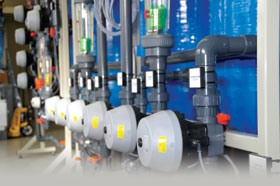

Metallic surface coating of work pieces and objects is generally performed to protect them from corrosion or wear. However, coatings can also be used to achieve certain functional characteristics, such as electrical conductivity, or may also be applied with the aim of producing visually attractive surfaces.
In electroplating plants, work pieces are dipped into various process baths for this purpose. The different stages of the process consist of pre-treatment, metallisation and post treatment. Ion exchangers are often used in electroplating plants to treat raw water for production purposes, or to bind the substances contained in the various types of rinse water so that clean water can be fed back into the process. However, ion exchangers are also used in wastewater treatment as the last stage of cleaning before the cleaned wastewater can be fed into the local sewerage system.
Flow optimised Gemü R690 diaphragm valves and robust Gemü 800 flowmeters are used both in the upstream gravel filtration plants and in the ion exchangers operated by PWM Service.
Treatment of wastewater from electroplating plants
Despite numerous precautions, electroplating plants produce highly contaminated waste-water which cannot be put back into circulation and must therefore be treated appropriately before it is released into the environment.
During the in-house treatment of metal-containing wastewater, the dissolved metal ions are generally converted into poorly soluble compounds by means of chemical precipitation. The main load of heavy metals is separated out with caustic soda or slaked lime. Alongside the base metals of iron and aluminium, the heavy metals of chrome, zinc, nickel and copper are also often found in the wastewater. The solids of the resulting electroplating sludge accumulate as sediment on the bottom of the settling ponds and are subsequently dewatered using filter presses. The accumulated sludge is collected and fed to a downstream recycling process.
In order to remove further solids, gravel filtration plants are connected downstream of the filter presses, in which the wastewater separated from the sludge is subjected to another process to remove any remaining heavy metal residues (slip). Before release into the local sewerage system (final inspection), the water is fed through selective ion exchangers, often called end-of-pipe exchangers, for a final precision cleaning process. This end-of-pipe treatment is a final environmental protection process which ensures compliance with the discharge limits.
Use of Gemü products in gravel filters and ion exchangers
The gravel filters are filled with coarse gravel (bottom) and finer gravel (top) and the contaminated water flows through them from top to bottom. The filters are flushed from bottom to top with fresh water in order to backwash the system. Aside from the wastewater (reticulated into the wastewater system), no further waste is produced. By using two gravel filtration units, one filter can always be in operation while the other is backwashed.
The end-of-pipe exchangers used for precision cleaning offer a number of advantages. For example, they can absorb very low residual concentrations and trace contaminants of metal. They also remove the need for expensive and environmentally harmful organosulphide precipitants. The system also makes it possible to recover resources. The ion exchangers (selective exchangers, e.g. Lewatit TP207) are regenerated and conditioned with hydrochloric acid and caustic soda.
The flow optimised Gemü R690 diaphragm valves (pneumatic) reliably channel the different water flows for filling, discharging, backwashing and regeneration to the gravel filters and ion exchangers.
For more information contact Claudio Darpin, Gemü Valves Africa, +27 (0)11 462 7795, [email protected], www.gemu-group.com
© Technews Publishing (Pty) Ltd | All Rights Reserved